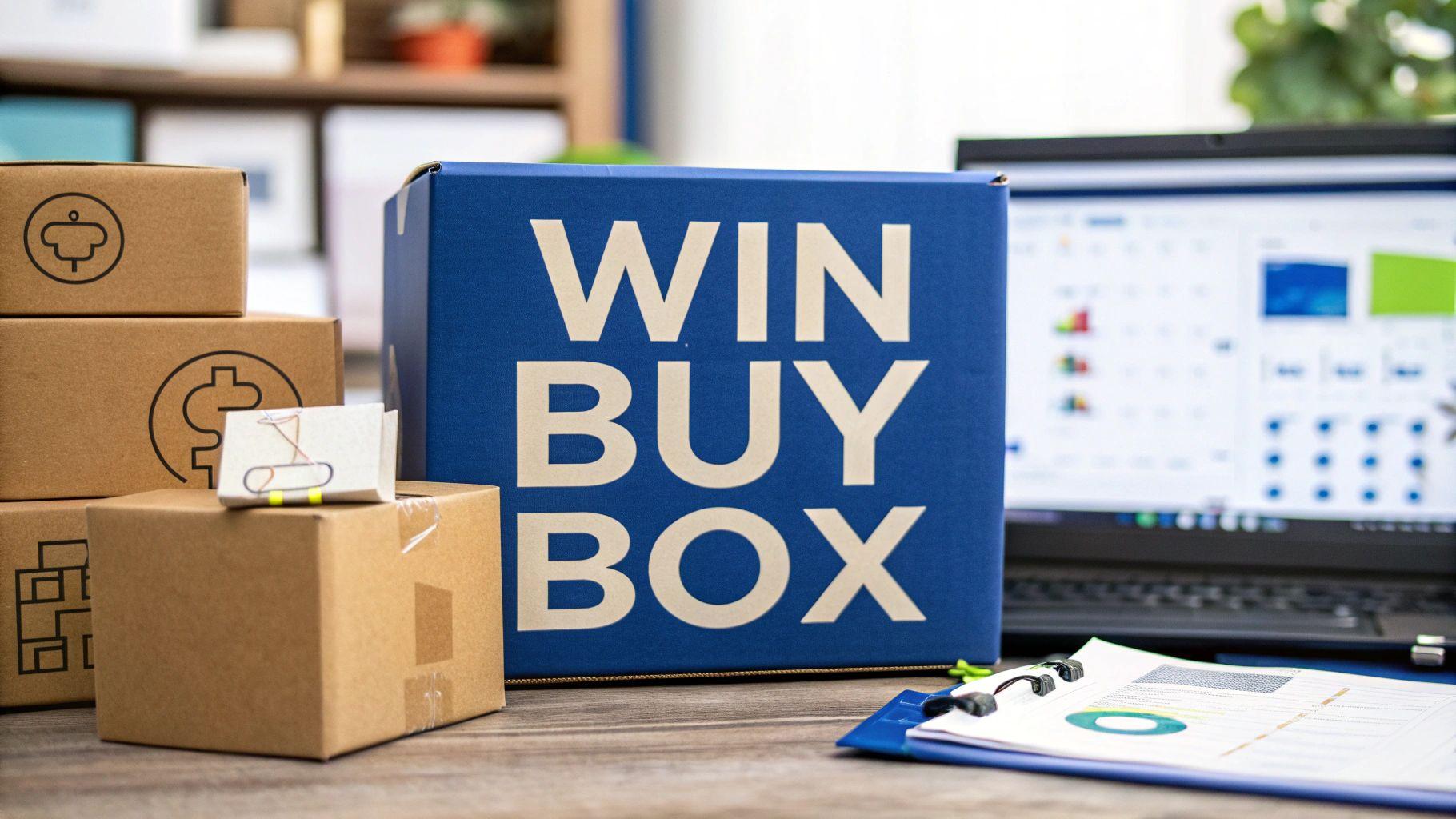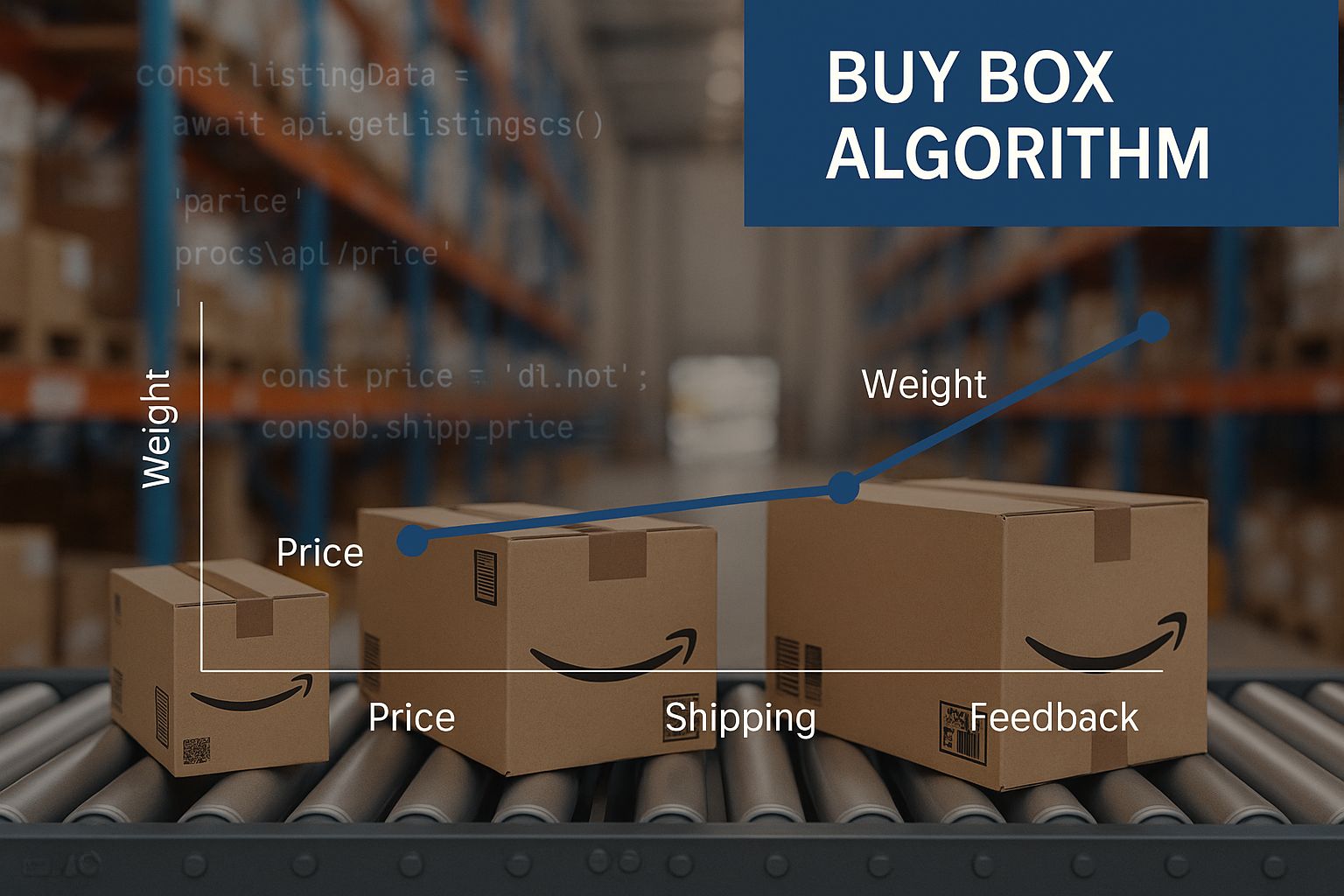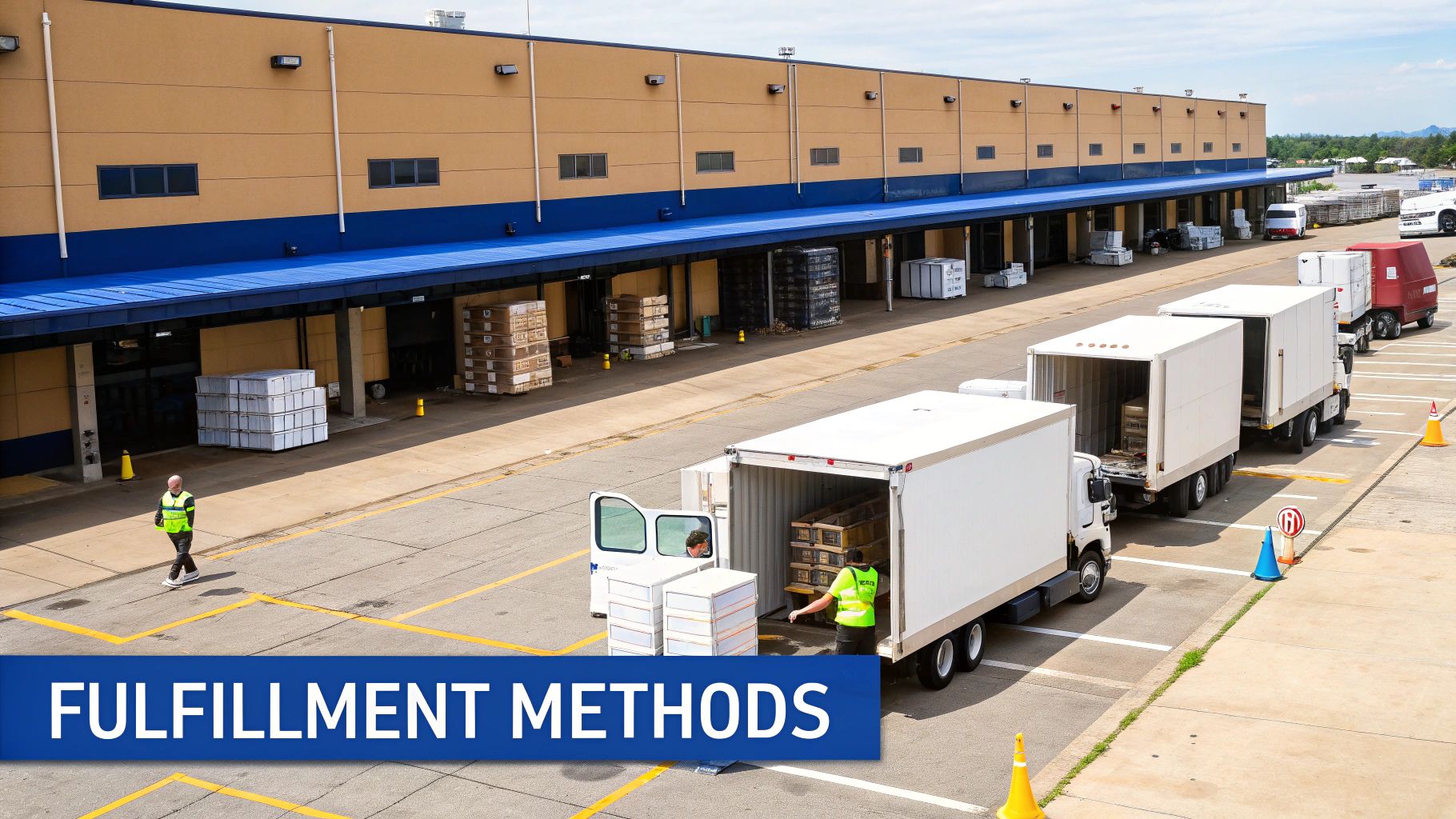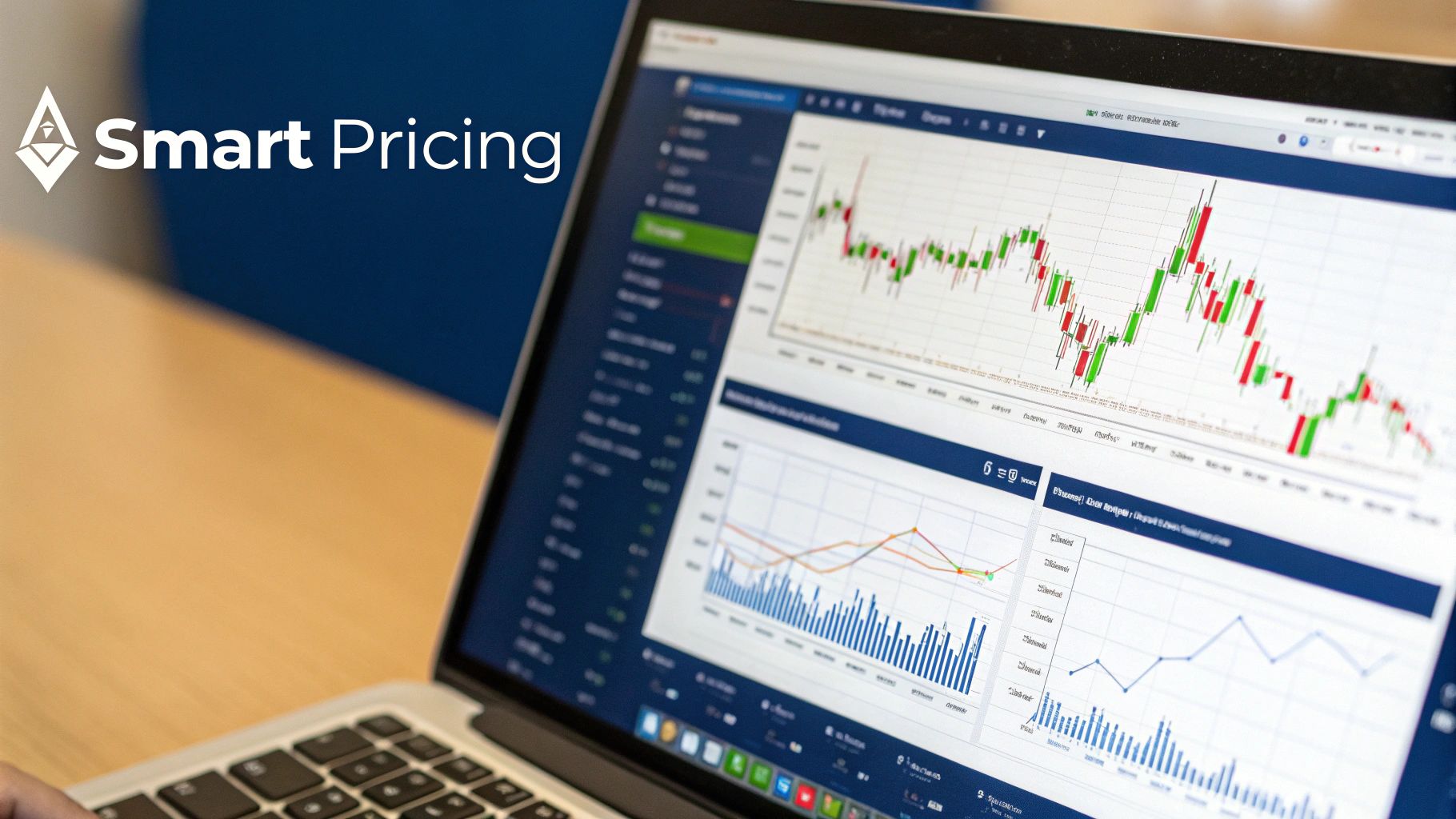How to Win the Amazon Buy Box: A Performance-First Guide
Learn how to win the buy box on Amazon with our expert guide. Discover tips on pricing, fulfillment, and performance to boost your sales and win the buy box amazon.

If you want to scale on Amazon, you need to own the Buy Box. It’s that simple. Capturing that coveted spot is the direct result of how well you manage three performance pillars: your fulfillment method, your landed price, and your overall seller metrics. Master these, and you're positioned for growth, because the Buy Box drives over 82% of all Amazon sales—and even more on mobile.
What's Really Driving the Amazon Buy Box?
The Buy Box isn't a prize; it's an endorsement. It’s the output of Amazon's algorithm, which is ruthlessly focused on delivering the best possible customer experience. When Amazon awards you the Buy Box, it's a direct signal to shoppers: "This is the seller we trust to deliver." For any brand serious about sustainable growth, securing this position is non-negotiable.
If you're not in that box, you're effectively invisible to the vast majority of ready-to-buy customers. The algorithm is constantly processing data across a host of seller variables to decide who earns that prime digital real estate. This process is deeply connected to the core ranking factors of the platform, which you can explore in our guide to Amazon's A9 algorithm.
The Three Pillars of Winning the Buy Box
To consistently win the Buy Box, you must align your operations with Amazon's core principles. While the exact formula is a closely guarded secret, the most heavily weighted variables are clear. A winning strategy relentlessly optimizes these three areas.
- Fulfillment & Speed: Your logistics method is arguably the single most important factor. Using Fulfillment by Amazon (FBA) or the elite Seller-Fulfilled Prime (SFP) program provides a decisive advantage. Why? Because Amazon trusts its own network to guarantee the speed and reliability its customers demand.
- Landed Price: This isn't just your item price; it's the total cost to the customer, including shipping. You don't always need to be the cheapest, but your pricing must be competitive within the context of your fulfillment speed and seller reputation.
- Seller Performance Metrics: Your account health is Amazon's scorecard for the customer experience you provide. Key metrics like Order Defect Rate (ODR), Cancellation Rate, and Late Shipment Rate are under constant scrutiny.
This infographic illustrates how these components interlock.

As you can see, Buy Box ownership isn't about excelling in one area. It's about maintaining a strong, balanced performance across the entire operational stack.
To help you translate these concepts into action, here’s a summary of what Amazon’s algorithm prioritizes and where your strategic focus should be.
Key Factors Influencing Your Buy Box Win Rate
| Factor | What It Means for Sellers | Strategic Focus |
|---|---|---|
| Fulfillment Method | How the product reaches the customer. FBA and SFP are heavily favored. | Prioritize FBA for key ASINs to leverage Amazon's logistics and gain a decisive algorithmic advantage. |
| Landed Price | The total cost to the customer (item price + shipping). | Implement dynamic repricing to remain competitive without sacrificing margin. Remember: a slightly higher FBA price often beats a lower FBM price. |
| Shipping Time | The promised delivery speed. Prime's two-day promise is the gold standard. | For FBM, your operations must be flawless: ship same-day or next-day and offer expedited options to even begin to compete with FBA. |
| Order Defect Rate (ODR) | A measure of negative feedback, A-to-Z claims, and chargebacks. Must be <1%. | Deliver exceptional customer service, ensure product listings are accurate, and resolve issues proactively to keep this metric near zero. |
| Seller Feedback Score | Your aggregate customer rating over 12 months. | Systematically solicit feedback and professionally address negative reviews to demonstrate your commitment to customer satisfaction. |
| Inventory Availability | Having products in stock and ready to ship. | Implement robust demand forecasting and inventory management to prevent stockouts, which immediately disqualify you from the Buy Box. |
Ultimately, a winning strategy is about more than just hitting targets; it's about building a reputation for operational excellence that the algorithm can't ignore.
Key Takeaway: The Buy Box is earned through performance, not just price. Focus on delivering a flawless, data-backed customer experience—from click to delivery. Amazon’s algorithm is engineered to reward sellers who mirror its own obsession with customer satisfaction.
Choosing the Right Fulfillment Method to Compete
Your fulfillment strategy is a critical component of your Buy Box performance. It's not merely a logistics choice; it's a direct signal of reliability to Amazon's algorithm. The decision between Fulfillment by Amazon (FBA), Seller-Fulfilled Prime (SFP), and Fulfillment by Merchant (FBM) has profound implications for your Buy Box eligibility, operational model, and profitability.

Why FBA Is the Fast Track to the Buy Box
For most brands, Fulfillment by Amazon (FBA) is the most direct path to dominating the Buy Box. By leveraging FBA, you outsource storage, picking, packing, and shipping to Amazon. The strategic advantage, however, is that your products automatically become Prime-eligible, a status the algorithm heavily favors.
Prime eligibility is your golden ticket. It's why an FBA seller can often price a product higher than an FBM competitor and still secure the Buy Box. Amazon inherently trusts its own fulfillment network to deliver on the Prime promise of speed and reliability, and it rewards sellers who adopt that system.
Consider this real-world scenario:
- Seller A (FBA): Lists a product at $25.99 with Prime shipping.
- Seller B (FBM): Lists the same product at $24.99 with standard 3-5 day shipping.
In the vast majority of cases, Seller A wins the Buy Box. The algorithm values the superior customer experience of guaranteed two-day shipping more than the FBM seller's marginal price advantage. The message is clear: the delivery promise is paramount.
Can You Compete with FBM or SFP?
While FBA offers a powerful advantage, it isn't the only option. High-performing merchants using Fulfillment by Merchant (FBM) can compete, but it requires operational perfection. To succeed with FBM, your logistics must operate with the precision and speed of an Amazon fulfillment center.
This means consistently hitting these benchmarks:
- Ship Fast: Fulfill orders within 24 hours.
- Track Everything: Maintain a Valid Tracking Rate (VTR) above 95%.
- Deliver on Time: Keep your Late Shipment Rate (LSR) below 4%.
For FBM sellers who have truly mastered their logistics, Seller-Fulfilled Prime (SFP) is the next frontier. SFP allows you to display the Prime badge while shipping from your own warehouse. Be warned: achieving and maintaining SFP status is exceptionally difficult. You must prove you can meet Amazon's strict two-day delivery promise nationwide, a feat that demands a highly sophisticated logistics network.
The Bottom Line: Your fulfillment choice is a strategic decision. FBA provides an immediate Buy Box advantage. FBM and SFP offer greater control but require flawless operational execution.
Making a Data-Backed Decision
This isn't just about winning the Buy Box; it's about doing so profitably. You must analyze FBA fees, storage costs, and your own fulfillment expenses to determine the optimal strategy. Many successful brands employ a hybrid model: they place high-velocity ASINs in FBA to maximize Buy Box ownership and use FBM for slower-moving or oversized items where FBA fees would erode margins.
The data is clear: fulfillment speed is a non-negotiable factor. While competitive pricing remains critical, it's no longer the sole determinant. As these in-depth Amazon statistics confirm, listings fulfilled via FBA and SFP have a significantly higher Buy Box win rate.
Ultimately, your fulfillment method is your operational promise to Amazon's customers. The more your strategy aligns with Amazon’s obsession with customer experience, the greater your control over the Buy Box will be.
Architecting a Profitable Pricing Strategy
Too many brands fall into the trap of thinking the lowest price automatically wins the Buy Box. This is a dangerous misconception that leads to a race to the bottom, eroding margins and making sustainable growth impossible.
The reality is that Amazon’s algorithm evaluates the landed price—the total cost to the customer, including shipping—within the context of your overall performance. Your objective isn't just to win the Buy Box; it's to win it at the highest possible price that still secures the sale.

Fixating on being the cheapest option devalues your brand and starves your business of the capital needed for growth. A strategic approach to pricing uses data and automation to capture the Buy Box profitably, protecting your margins and fueling your sales engine.
Ditch Manual Price Adjustments
Attempting to manually track and react to competitor pricing is an exercise in futility. It’s a reactive, unwinnable game. By the time you identify a price change and update your listing, the market has already shifted.
This is precisely why dynamic repricing software is no longer a luxury; it's a foundational tool for any serious Amazon brand.
Sophisticated repricers aren't just about undercutting competitors. They are automated pricing strategists, operating 24/7. They analyze competitor movements, inventory levels, seller metrics, and other real-time data to make intelligent, calculated adjustments designed to maximize both sales and profit.
An AI-powered repricer can execute hundreds of micro-adjustments per hour—a task no human could manage. This allows you to capture the Buy Box during brief windows of opportunity (e.g., when a competitor stocks out) and incrementally increase prices when you have a competitive advantage, adding up to significant gains in revenue and profit.
Implement Intelligent Repricing Rules
The power of a repricer lies in the strategic rules you define. This is not a "set it and forget it" tool. Your strategy must be directly tied to your business objectives. Abandon the naive "price $0.01 below the lowest competitor" rule and adopt a more sophisticated approach.
Here are examples of intelligent rules that drive profitable growth:
- Compete with FBA Offers Only: Why engage in a price war with a low-rated FBM seller when the algorithm heavily favors you? Configure your tool to compete only against other FBA offers.
- Price Up When Competitors Stock Out: If the Buy Box holder runs out of inventory, your repricer should automatically and instantly raise your price to capture the sale at a healthier margin.
- Establish a Profitability Floor: This is non-negotiable. Calculate your break-even point for each ASIN and set a minimum price floor. This ensures you never sell at a loss. Protecting your bottom line starts with knowing your numbers; our guide on how to calculate profit margins can help.
- Leverage Your Seller Rating: If your feedback score is superior to your primary competitor's, you can often price slightly higher and still win the Buy Box. Create rules to be less aggressive against sellers with weaker metrics.
Always Put Profitability First
Your pricing strategy is a direct reflection of your brand's financial health on Amazon. Every decision must be made with profitability as the primary objective. This requires a deep understanding of your entire cost structure—from COGS and shipping to FBA fees and advertising spend—before setting your repricing parameters.
For a deeper dive, explore this guide on effective Amazon pricing strategies. It provides valuable frameworks for optimizing both sales velocity and profit.
The most successful brands on Amazon don't just win the Buy Box—they control it on their own terms. They ensure every sale contributes to sustainable, long-term growth. Your pricing strategy should be your most powerful tool for achieving that dominance, not a fast track to margin erosion.
If pricing and fulfillment are the engine of your Buy Box strategy, your seller performance metrics are the fuel. These numbers are a direct measure of the customer experience you deliver, and Amazon’s algorithm is paying close attention.
A pristine account health dashboard is your ticket to compete. It signals to Amazon that you are a reliable, customer-centric partner. Dialing in your operations isn't just good business practice—it's how you gain a measurable competitive edge.
The Metrics That Truly Matter
Amazon doesn't guess which sellers are best; it uses data. A few key metrics carry disproportionate weight in determining Buy Box eligibility. If you focus on anything, focus on these.
- Order Defect Rate (ODR): This is the ultimate measure of customer satisfaction. It combines negative feedback, A-to-Z Guarantee claims, and credit card chargebacks. A rising ODR is a critical warning sign that your customer experience is failing.
- Cancellation Rate (CR): This tracks how often you cancel a customer's order pre-fulfillment. A high CR indicates poor inventory management and creates a negative customer experience.
- Late Shipment Rate (LSR): This metric is simple: did you ship on time? Missing Amazon's expected ship date consistently tells the algorithm you cannot be trusted to meet customer expectations.
These aren't suggestions; they are hard requirements. To be eligible for the Buy Box, your Order Defect Rate (ODR) must remain below 1%. Your Late Shipment Rate (LSR) must be under 4%, and your Pre-fulfillment Cancellation Rate (CR) must be below 2.5%. You can find more details on these crucial Buy Box metrics to understand their precise impact on the algorithm.
Turning Operational Excellence into Buy Box Dominance
Maintaining strong metrics isn't just about avoiding penalties; it’s an offensive strategy. A seller with a 0.1% ODR will consistently beat a competitor with a 0.8% ODR, even at a slightly higher price point. Amazon rewards reliability.
So, how do you make these numbers work for you?
The Takeaway: Your performance metrics are a direct dialogue with Amazon’s algorithm. Every on-time shipment, positive review, and avoided cancellation reinforces your status as a top-tier seller worthy of the Buy Box. Operational excellence is your most sustainable competitive advantage.
For instance, disciplined inventory management is your primary defense against a high Cancellation Rate. Use forecasting tools to anticipate demand, ensuring your key ASINs are always in stock, especially when running ad campaigns. A stockout doesn't just cost you a sale—it damages the very metrics that grant you Buy Box eligibility.
Similarly, a streamlined shipping process is essential for keeping your Late Shipment Rate near zero. This could mean implementing daily order cut-off times or integrating shipping software with Seller Central to eliminate manual errors. Every minute saved in your fulfillment process protects your LSR.
Here’s a breakdown of the core metrics, Amazon's targets, and the strategic implications.
This table summarizes the most important metrics. Treat these as the key performance indicators (KPIs) for your Amazon operations.
Critical Amazon Seller Performance Metrics and Targets
| Metric | Amazon's Target | Impact on Buy Box Eligibility |
|---|---|---|
| Order Defect Rate (ODR) | Below 1% | High Impact: Exceeding this threshold can lead to immediate loss of the Buy Box and even account suspension. |
| Cancellation Rate (CR) | Below 2.5% | Medium Impact: A high rate signals poor inventory control, making you appear unreliable to the algorithm. |
| Late Shipment Rate (LSR) | Below 4% | Medium Impact: Consistently shipping late demonstrates an inability to meet customer delivery expectations. |
| Valid Tracking Rate (VTR) | Above 95% | High Impact: Failure to provide valid tracking information erodes customer trust and severely harms your eligibility. |
Adhering to these targets isn't about compliance; it's about building a resilient and profitable business on the Amazon platform.
Ultimately, these metrics are interconnected. A late shipment can lead to negative feedback, which in turn increases your Order Defect Rate. This is why a "performance-first" mindset is crucial. The brands that treat operational excellence as a strategic priority are the ones who dominate the Buy Box and build a defensible, long-term business on Amazon.
Using PPC to Influence Your Buy Box Share
Viewing Pay-Per-Click (PPC) advertising as merely a sales channel is a common and costly mistake. For sophisticated brands, PPC is a strategic lever—a powerful tool for influencing organic rank, sales velocity, and, ultimately, long-term Buy Box ownership. Shift your mindset from treating ad spend as a cost center to viewing it as a strategic investment in spinning the Amazon flywheel.
A well-executed ad campaign drives sales velocity—the rate and volume of your sales over time. This is one of the most powerful signals you can send to Amazon's A9 algorithm. High sales velocity tells the algorithm that your product is in demand and resonates with customers. This increased demand directly improves your organic search placement, which in turn dramatically increases your probability of winning and holding the Buy Box.
PPC as a Buy Box Accelerator
The connection between advertising and the Buy Box is causal, not coincidental. When you launch a Sponsored Products campaign, you are purchasing visibility on the search results page. This increased traffic, combined with a well-optimized listing, generates incremental sales.
This spike in sales velocity, though initiated by paid traffic, is a crucial input for the Buy Box algorithm. It validates your offer's relevance and appeal. Sustaining this momentum strengthens your product's authority on the platform, making it a more favorable candidate to win the Buy Box even when your ads are not active.
The Headline POV: If you only measure PPC success by ACoS, you're missing the strategic picture. The true value of an effective ad strategy is its impact on your total organic presence. Sales velocity from ads improves organic rank, which increases total sessions and strengthens your claim on the Buy Box. This creates a self-reinforcing cycle of profitable growth.
A Framework for Buy Box-Focused Campaigns
To make this synergy work, you must align PPC efforts with your Buy Box objectives. This requires a precise and strategic approach, not simply activating auto-campaigns. If you need to build a foundation, our primer on what Amazon Pay-Per-Click is is an excellent starting point.
Here is a practical framework for architecting ad campaigns to win the Buy Box:
- Target High-Potential ASINs: Concentrate your ad spend on products that are already "Buy Box eligible" and demonstrate high conversion potential—those with strong reviews, competitive pricing, and ample inventory.
- Defend Branded Keywords: Competitors are actively bidding on your brand name to intercept your customers. Run Sponsored Brands and Sponsored Products campaigns on your own branded terms to build a defensive moat, ensuring that shoppers searching for you find your offer in the Buy Box.
- Utilize "Top of Search" Placements Strategically: For new product launches or during key retail moments like Prime Day, an aggressive top-of-search bidding strategy is warranted. This maximizes visibility to generate the initial sales velocity needed to enter the Buy Box rotation quickly.
- Correlate Ad Spend with Buy Box Win Rate: Monitor your analytics. If your Buy Box ownership percentage declines when you pause ad spend on a key ASIN, that is clear data demonstrating that paid campaigns are directly supporting your organic performance.
PPC is one of the few levers you can proactively pull to influence the sales data that the Buy Box algorithm values most. While factors like pricing and fulfillment are about meeting Amazon's operational standards (table stakes), advertising is how you actively prove your product's market demand. When you leverage PPC to drive sales velocity, you create a powerful, sustainable advantage that helps you not just win the Buy Box, but own it.
Putting It All Together: Your Buy Box Game Plan
Consistently winning the Amazon Buy Box isn't about a single hack or secret tactic. It's about executing an integrated strategy where every component of your operation—from fulfillment logistics to advertising—works in concert. This is a continuous cycle of optimization, driven by performance data.
A holistic plan also means securing your foundational assets. Protecting your brand is paramount. A critical, often overlooked, element of long-term success is securing trademarks to dominate the Amazon marketplace, which provides a powerful defense against hijackers and counterfeiters.
The Four Pillars of Buy Box Success
I've seen countless brands attempt to win on price alone, only to destroy their margins and fail. The path to profitable Buy Box ownership is built on four interconnected pillars. If one is weak, the entire structure is compromised.
- Flawless Fulfillment: Make FBA the default for your most critical products. The Prime badge is the single most powerful lever you can pull, frequently outweighing slightly lower prices from FBM sellers.
- Intelligent Pricing: Abandon the race to the bottom. Deploy a high-quality automated repricer with smart rules that defend your profit margins. Your true competition is other high-performing FBA sellers; focus your strategy there.
- Impeccable Account Health: Monitor your performance metrics relentlessly. Your Order Defect Rate must be kept below 1%, and your Late Shipment Rate under 4%. These are not just dashboard numbers; they are direct inputs into the Buy Box algorithm.
- Strategic Advertising: Use Amazon PPC to generate and sustain sales velocity. A well-managed ad campaign drives immediate sales while simultaneously boosting your organic rank over time, strengthening your long-term Buy Box eligibility.
The Bottom Line: The Buy Box is a reward for operational excellence. When you master your operations and amplify your success with strategic advertising, you stop chasing the Buy Box and start owning it. It transforms from a daily tactical battle into a predictable engine for profitable growth.
Got Questions About the Buy Box? We've Got Answers
The Amazon Buy Box can feel like a black box, even for experienced sellers. Let's address some of the most common questions leaders ask when trying to build a consistent winning strategy.
Can I Really Win the Buy Box with a Higher Price?
Absolutely. Price is a significant factor, but it is not the only factor. Amazon's primary goal is customer satisfaction. The algorithm is designed to predict which seller will provide the best overall experience.
Therefore, if you are using FBA and have stellar performance metrics (e.g., a near-zero Order Defect Rate), you can often price higher than an FBM seller with slower shipping and still win the Buy Box. The algorithm values your demonstrated reliability, which is often worth a premium to the end customer.
How Often Does the Buy Box Winner Actually Change?
Continuously. The Buy Box can rotate between sellers multiple times per day, sometimes even multiple times per hour for highly competitive listings. The algorithm is constantly re-evaluating real-time data on pricing, inventory levels, and seller performance.
This is precisely why manual repricing is an obsolete strategy. By the time you react to a competitor's price change, the market dynamics have already shifted. An automated, rule-based repricer is essential to remain competitive.
The Big Picture: Winning the Buy Box is not a static achievement. It is a dynamic position awarded to the seller offering the optimal combination of price, speed, and reliability at any given moment. Continuous performance is key.
Does Running PPC Ads Help Me Win the Buy Box?
Yes, but indirectly. You cannot pay for placement in the Buy Box. However, PPC is a critical tool for influencing the factors the algorithm does consider. A strategic ad campaign increases your sales velocity, which is a powerful signal of product popularity and demand to Amazon.
As sales velocity increases, your organic ranking improves. This builds the product's overall authority and relevance on the platform, making you a stronger, more frequent contender for the Buy Box. It's not a direct purchase of the Buy Box, but a strategic investment in the Amazon flywheel that drives both organic and paid success.
At Headline Marketing Agency, we don't just manage ad spend—we architect performance-driven PPC strategies that create a flywheel of growth. We focus on building the sales velocity that leads to long-term, profitable Buy Box ownership. See how we scale brands on headlinema.com.
Ready to Transform Your Amazon PPC Performance?
Get a comprehensive audit of your Amazon PPC campaigns and discover untapped growth opportunities.